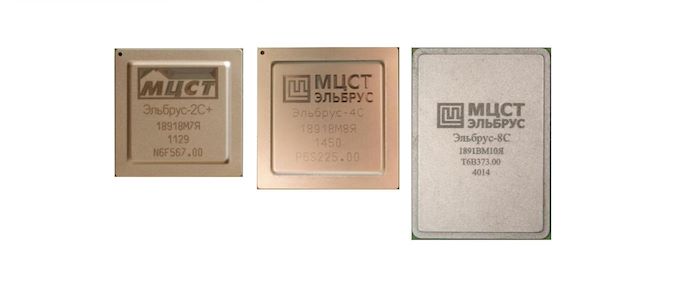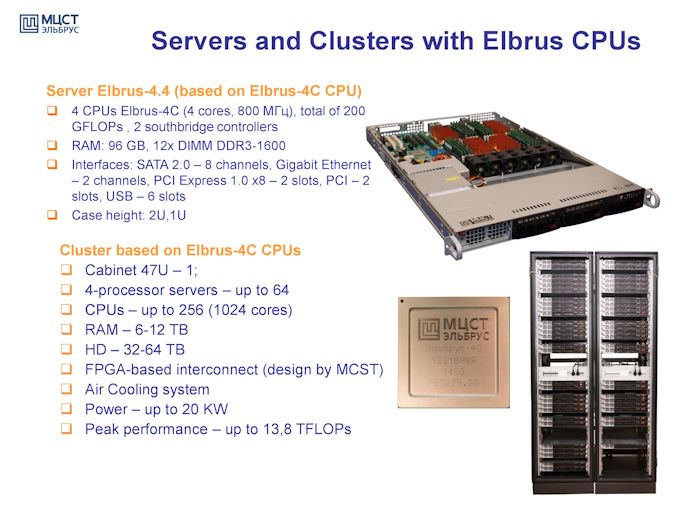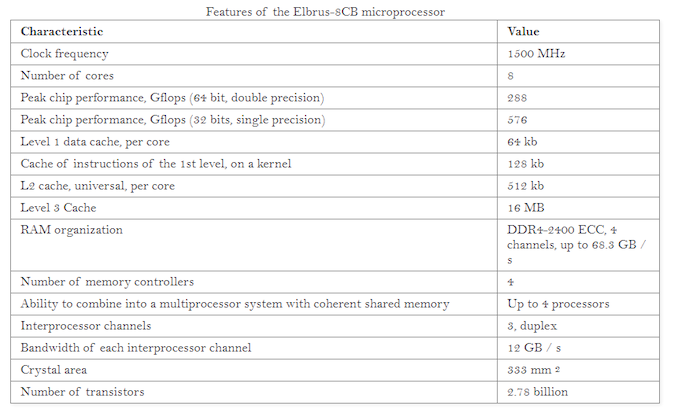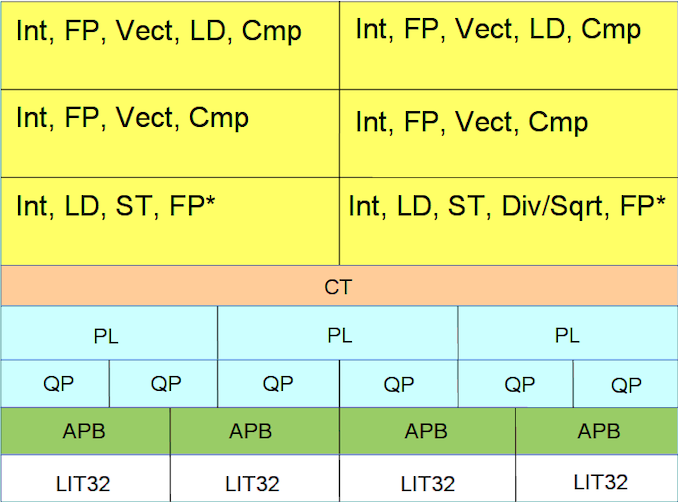Russia’s Elbrus 8CB Microarchitecture: 8-core VLIW on TSMC 28nm
by Dr. Ian Cutress on June 1, 2020 8:00 AM EST
All of the world’s major superpowers have a vested interest in building their own custom silicon processors. The vital ingredient to this allows the superpower to wean itself off of US-based processors, guarantee there are no supplemental backdoors, and if needed add their own. As we have seen with China, custom chip designs, x86-based joint ventures, or Arm derivatives seem to be the order of the day. So in comes Russia, with its custom Elbrus VLIW design that seems to have its roots in SPARC.
Russia has been creating processors called Elbrus for a number of years now. For those of us outside Russia, it has mostly been a big question mark as to what is actually under the hood – these chips are built for custom servers and office PCs, often at the direction of the Russian government and its requirements. We have had glimpses of the design, thanks to documents from Russian supercomputing events, however these are a few years old now. If you are not in Russia, you are unlikely to ever get your hands on one at any rate. However, it recently came to our attention of a new programming guide listed online for the latest Elbrus-8CB processor designs.
The latest Elbrus-8CB chip, as detailed in the new online programming guide published this week, built on TSMC’s 28nm, is a 333 mm2 design featuring 8 cores at 1.5 GHz. Peak throughput according to the documents states 576 GFLOPs of single precision, with the chip offering four channels of DDR4-2400, good for 68.3 GB/s. The L1 and L2 caches are private, with a 64 kB L1-D cache, a 128 kB L1-I cache, and a 512 kB L2 cache. The L3 cache is shared between the cores, at 2 MB/core for a total of 16 MB. The processor also supports 4-way server multiprocessor combinations, although it does not say on what protocol or what bandwidth.
It is a compiler focused design, much like some other complex chips, in that most of the optimizations happen at the compiler level. Based on compiler first designs in the past, that typically does not make for a successful product. Documents from 2015 state that a continuing goal of the Elbrus design is x86 and x86-64 binary translation with only a 20% overhead, allowing full support for x86 code as well as x86 operating systems, including Windows 7 (this may have been updated since 2015).
The core has six execution ports, with many ports being multi-capable. For example, four of the ports can be load ports, and two of the ports can be store ports, but all of them can do integer operations and most can do floating point operations. Four of the ports can do comparison operations, and those four ports can also do vector compute.
This short news post is not meant to be a complete breakdown of the Elbrus capabilities – we have amusingly joked internally at what frequency a Cortex X1 with x86 translation would match the capabilities of the 8-core Elbrus, however users who want to get to grips with the design can open and read the documentation at the following address:
http://ftp.altlinux.org/pub/people/mike/elbrus/docs/elbrus_prog/html/index.html
The bigger question is going to be how likely any of these state-funded processor development projects are going to succeed at scale. State-funded groups should, theoretically, be the best funded, however even with all the money in the world, engineers are still required to get things done. Even if there ends up being a new super-CPU for a given superpower, there will always be vested interests in an amount of security though obscurity, especially if the hardware is designed specifically to cater to state-secret levels of compute. There's also the added complication of the US government tightening its screws around TSMC and ASML to not accept orders from specific companies - any plans to expand those boundaries could occur, depending how good the products are or how threatened some nations involved feel.
Source: Blu (Twitter)














93 Comments
View All Comments
mshigorin - Tuesday, June 2, 2020 - link
He also seems to have confused Intel and friends with "the whole industry", amusingly.We've heard that before -- with "the whole world(tm)" under French command, then German, and now there's a next arrogant outsider on their history lessons. It's not just about IT.
Just to be clear, I am not to be considered smart at all -- learned myself reading before 3, won some olympiads, earned my M.Sc. in chemistry, and by any margin am no compiler developer at all, let alone VLIW/EPIC ones.
But a humble user and distromaker can have their voice on the facts observed, eh? :-)
mode_13h - Monday, June 1, 2020 - link
IA64 wasn't VLIW, it was EPIC - Explicitly Parallel Instruction Computing. The idea is to make the data dependencies explicit, which simplifies dynamic scheduling but doesn't prevent it. Theoretically, EPIC CPUs could OoO and even speculative execution.In true VLIW, the scheduling is 100% compile-time.
mshigorin - Monday, June 1, 2020 - link
Well Elbrus does speculative execution indeed, it's mentioned in Chapter 6 of the book in question: http://ftp.altlinux.org/pub/people/mike/elbrus/doc...mode_13h - Monday, June 1, 2020 - link
Sweet! Thank you!:)
mshigorin - Monday, June 1, 2020 - link
> None of ARM, AMD, Intel are state-fundedPfft, do you even know the origin of Pentim Pro or, well, the whole ARM affair? In that sense, MCST isn't state funded either.
laurakmullinax - Tuesday, June 9, 2020 - link
Follow guide we have for you and you can make 90 dollars every hour… Our agents earn around $12k a month… Join them… and start working from comfort of your home! All you need is a computer and a internet connection and you are ready to start. Learn how to make a steady income for yourself on following web adress… WWW. iⅭash68.ⅭOⅯElstar - Monday, June 1, 2020 - link
State-funded technology can work well when the fundamental problem is constrained by research. That being said, once the problem area is well understood, state-funded technology tends to fall behind what the market can produce because state-funded technology is built to please bureaucrats, not customers.So with this perspective, we shouldn't surprise us that this design uses VLIW, which gets the superficial "MIPS/dollar" that politicians want, but struggles with general purpose code.
Xex360 - Monday, June 1, 2020 - link
Agreed, State run programmes should focus more on cutting edge technologies, where the immediate financial benefits aren't clear or low, it took more than a half a century for the private sector to send people to space with much more advanced technologies and knowledge.FunBunny2 - Monday, June 1, 2020 - link
"much more advanced technologies and knowledge"you really think so? the Falcon 9 is the same motor as in the 1957 Vanguard, which blew up 8 of 11 instances. yes, rather than dials and switches there's a GUI, but that's just another example of lipstick on a pig. yes, today's microprocessors allow for returnable boosters, at the cost of lower payload. but without the GPS satellites (that's a guess as I type) and other infrastructure, much of it paid for (and some built) by the Damn Gummint, Falcon 9 would be very little different from the Vanguard. could landing be done simply with inertial guidance? I doubt it, but then I'm not a rocket scientist.
MamiyaOtaru - Monday, June 1, 2020 - link
what, you think we don't have more advanced technologies and knowledge now than we did 50 years ago? Sure the limited instance of a rocket motor has been pretty well solved and was a long time ago, but everything surrounding it has advanced by leaps and bounds, and it still took this long for private industry to catch up to what the government was doing then with respect to space flight, which was his point. What's yours? I'm really not sure.